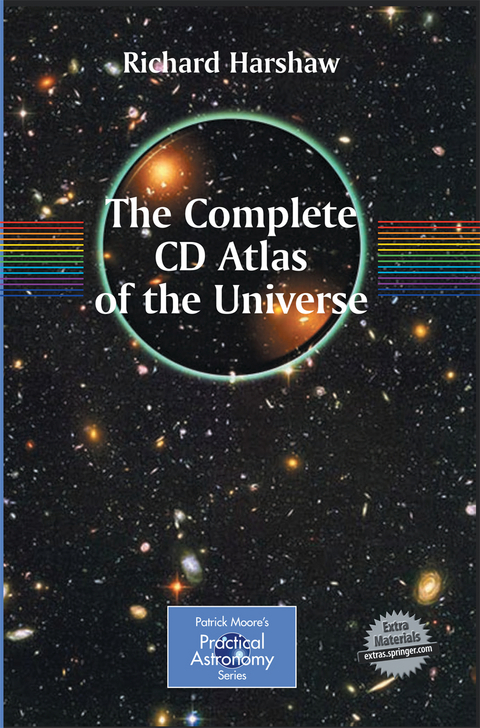
The Complete CD Guide to the Universe
Springer-Verlag New York Inc.
978-1-4899-9738-8 (ISBN)
This is without doubt the largest and most comprehensive atlas of the universe ever created for amateur astronomers. It is the first major observing guide for amateurs since Burnham’s Celestial Handbook. With finder charts of large-scale and unprecedented detail, in both normal and mirror-image views (for users of the ubiquitous Meade and Celestron Schmidt-Cassegrain telescope ranges), and an extensive list of 14,000 objects, it will provide a detailed observing guide for almost any practical amateur astronomer, up to the most advanced.Spanning some 3,000 pages, this is a project that is possible only with Springer Extra Materials, http://extras.springer.com.The atlas covers the whole range of objects viewable by amateur astronomers with 8- to 11-inch telescopes, from latitude approx +40 degrees. The projected total number of objects is (currently) 13,238, compared with Burnham’s approximately 5,000 double stars (in three volumes). This is much more than just a catalog of objects.As planned, the atlas will have about 270 double star images and sketches, and 590 or so deep-sky images and sketches. Comparisons with other atlases are invidious, but Tirion’s atlas and Uranometria, for example, don’t go as deep in magnitude and the scale is unsuitable for "star hopping" in the eyepiece—where the action REALLY takes place. The charts in the Complete CD Atlas of the Universe and the scale they are on, allow the user to get enough detail to easily find the objects described. In addition mirror-image charts are supplied for instruments with reverse fields (all SCTs).This is also much more than ‘planetarium’ software.Many planetarium programs do not have good object databases, and those that do have databases that are too large for practical field use. For example, TheSky, one of the most popular (and best) programs, can display the entire Washington Double Star Catalog (some 120,000 doubles!), but 90% of these are not resolvable (or evenviewable from certain horizons), and there is no way to determine that by looking at the screen. The result is that there are more objects plotted on the screen than you can actually see, and the clutter makes it very hard to find what you want.The pages on Springer Extra Materials are extensively indexed and referenced for quick location of objects, areas, classes of objects etc..The accompanying book gives an introduction to the Atlas, showcases the maps (thus buyers can see what they are getting without visiting Springer Extra Materials), describes the Springer Extra Materials content and organization, and includes various appendices.
Richard Harshaw lives in Kansas, where he works as a consultant. During his 40 years of practical observing, (seventeen of them with large-aperture instruments) he has received eight Astronomical League observing awards, and has published measurements of approximately 1,600 double stars. His many published papers include Third Degree Views (The Webb Society’s Deep Sky Observer, No. 121, Summer 2000); Color in Double Stars (Deep Sky Observer, No. 116, April 1999); An Investigation Into Discrepancies In the Washington Double Star Catalog (Deep Sky Observer, No. 129); On Double Identities, Recovered Pairs, and Optical Imposters in the Washington Double Star Catalog (Webb Society Double Star Section Circular No. 12, 2004); New Measures for Some ‘Neglected’ Double Stars of the Washington Double Star Catalog (Double Star Section Circular No. 12, 2004); Possible Quadrant Reversals in the WDS Catalog 2001.0 (Double Star Section Circular No. 11, 2003).
Book: Introduction.- How to observe different types of objects.- How to rate the sky.- How to keep a log.- How to observe double stars.- Detailed instructions on how to use the CD-R, with screen shots, examples, and a tutorial.- Appendix : summaries of the CD-R contents.
CD-ROM: Approximately 3,000 pages (in PDF format) of maps and descriptive material, broken down as follows.- Double Stars.- Dark nebulae.- Bright nebulae.- Planetary nebulae.- Supernova remnants.- Open clusters.- Globular clusters.- Galaxies.- Quasi stellar objects.- Other.- Index.- Acrobat ® Reader.- Appendices.
| Erscheint lt. Verlag | 27.11.2014 |
|---|---|
| Reihe/Serie | The Patrick Moore Practical Astronomy Series |
| Zusatzinfo | XIV, 120 p. |
| Verlagsort | New York |
| Sprache | englisch |
| Maße | 155 x 235 mm |
| Themenwelt | Sachbuch/Ratgeber ► Natur / Technik ► Weltraum / Astronomie |
| Naturwissenschaften ► Physik / Astronomie ► Astronomie / Astrophysik | |
| ISBN-10 | 1-4899-9738-5 / 1489997385 |
| ISBN-13 | 978-1-4899-9738-8 / 9781489997388 |
| Zustand | Neuware |
| Haben Sie eine Frage zum Produkt? |
aus dem Bereich


